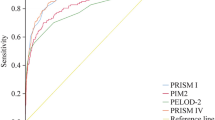Abstract
The pediatric risk of mortality score (PRISM) incorporates 14 physiological and laboratory variables to calculate a patient's score, which is then adjusted for operative status and age to determine the probability of death. Because of the ethical issues surrounding the initiation of dialysis in critically ill children, a scoring system which could differentiate survivors from nonsurvivors prior to the initiation of dialysis would be useful to the clinician. Similarly, a score which could accurately estimate the probability of mortality in children with acute renal failure would be useful to third party payors attempting to evaluate the performance of individual care providers. We calculated PRISM scores on the day dialysis was initiated, retrospectively, in 31 children seen from 1984–1988 with the diagnosis of acute renal failure and requiring dialysis, in order to determine if the PRISM score was accurate in prediction of mortality. In addition, we calculated scores on the day of admission to the intensive care unit (DICU) in order to see if DICU scores accurately reflected mortality risk. The mean PRISM scores of nonsurvivors were significantly higher than the mean scores of survivors on the day dialysis therapy was initiated. However, overlap in the scores of survivors and nonsurvivors would limit the applicability of PRISM scores for clinical decision making. Children that developed acute renal failure requiring dialysis due to extrarenal diseases had a higher mortality rate than those that had primary renal disease (57% versus 12.5%,P<0.05). DICU scores underestimated the mortality of these patients. The decision to institute dialysis for children with acute renal failure cannot be based on PRISM scores calculated during the hospital course. The use of PRISM scores in quality assurance activities for children with acute renal failure is inappropriate.
Similar content being viewed by others
References
Johnson MH, Gordon PW, Fitzgerald FT (1986) Stratification of prognosis in granulocytopenic patients with hematologic malignancies using the APACHE-II severity of illness score. Crit Care Med 14: 693–697
Fedullo AJ, Swinburne AJ, Wahl GW, Bixby KR (1988) Apache II score and mortality in respiratory failure due to cardiogenic pulmonary edema. Crit Care Med 16: 1218–1221
Kruse JA, Thill-Baharozian MC, Carlson RW (1988) Comparison of clinical assessment with APACHE II for predicting mortality risk in patients admitted to a medical intensive care unit. JAMA 260: 1739–1742
Brannen AL, Godfrey LJ, Goetter WE (1989) Prediction of outcome from critical illness: a comparison of clinical judgement with a prediction rule. Arch Intern Med 149: 1083–1086
Chang RWS, Lee B, Jacobs S, Lee B (1989) Accuracy of decisions to withdraw therapy in critically ill patients: clinical judgement versus a computer model. Crit Care Med 17: 1091–1097
Maher ER, Robinson KN, Scoble JE, Farrimond JG, Browne DRG, Sweny P, Moorhead JF (1989) Prognosis of critically-ill patients with acute renal failure: APACHE II score and other predictive factors. Q J Med 269: 857–866
Knaus WA, Rauss A, Alperovitch A, LeGall JR, Loirat P, Patois E, Marcus SE, the French Multicentric Group of ICU Research (1990) Do objective estimates of chances for survival influence decisions to withhold or withdraw treatment? Med Decis Making 10: 163–171
Pollack MM, Ruttimann UE, Getson PR (1988) Pediatric risk of mortality (PRISM) score. Crit Care Med 16: 1110–1116
Hodson EM, Kjellstrand CM, Mauer SM (1978) Acute renal failure in infants and children: outcome of 53 patients requiring hemodialysis treatment. J Pediatr 93: 756–761
Rothstein P, Johnson P (1982) Pediatric intensive care: factors that influence outcome. Crit Care Med 10: 34–37
Kilner JF (1990) Ethical issues in the initiation and termination of treatment. Am J Kidney Dis 15: 218–227
Yeh TS, Pollack MM, Ruttimann UE, Holbrook PR, Fields AI (1984) Validation of a physiologic stability index for use in critically ill infants and children. Pediatr Res 18: 445–451
Pollack MM, Ruttimann UE, Getson PR (1987) Accurate prediction of the outcome of pediatric intensive care: a new quantitative method. N Engl J Med 316: 134–139
Wilkinson JD, Pollack MM, Glass NL, Kanter RK, Katz RW, Steinhart CM (1987) Mortality associated with multiple organ system failure and sepsis in pediatric intensive care unit. J Pediatr 111: 324–328
Pollack MM, Wilkinson JD, Glass NL (1987) Long-stay pediatric intensive care unti patients: outcome and resource utilization. Pediatrics 80: 855–860
Ruttimann UE, Albert A, Pollack MM, Glass NL (1986) Dynamic assessment of severity of illness in pediatric intensive care. Crit Care Med 14: 215–221
Knaus WA, Wagner DP, Lynn J (1991) Short-term mortality predictions for critically ill hospitalized adults: science and ethics. Science 245: 389–394
Wagner D, Knaus W, Berger M (1989) Statistical methods. Crit Care Med 17: S194-S198
Pollack MM, Yeh TS, Ruttimann UE, Holbrook PR, Fields AI (1984) Evaluation of pediatric intensive care. Crit Care Med 12: 376–383
Knaus WA, Draper EA, Wagner DP, Zimmermann JE (1986) An evaluation of outcome from intensive care in major medical centers. Ann Intern Med 104: 410–418
Pollack MM, Getson PR (1991) Pediatric critical care cost containment: combined actuarial and clinical program. Crit Care Med 19: 12–20
Rosko MD (1988) DRG's and severity of illness measures: an analysis of patient classification systems. J Med Syst 12: 257–274
Iezzoni LI, Shwartz M, Restuccia J (1991) The role of severity information in health policy debates: a survey of state and regional concerns. Inquiry 28: 117–128
Zobel G, Kuttnig M, Ring E, Grubbauer HM (1990) Clinical scoring systems in children with continuous extracorporeal renal support. Child Nephrol Urol 10: 14–17
Author information
Authors and Affiliations
Rights and permissions
About this article
Cite this article
Fargason, C.A., Langman, C.B. Limitations of the pediatric risk of mortality score in assessing children with acute renal failure. Pediatr Nephrol 7, 703–707 (1993). https://doi.org/10.1007/BF01213327
Received:
Revised:
Accepted:
Issue Date:
DOI: https://doi.org/10.1007/BF01213327




